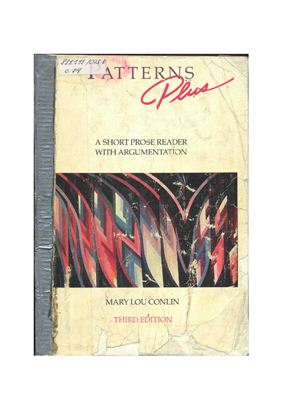A Short Prose Reader with Argumentation
Third Edition
Mary Lou Conlin
1990 by Houghton Mifflin Company
Printed in the U.S.A.
Acknowledgments for reprinted materials begin on page 423.
Pattes Plus, Third Edition, strives to give students a variety of models for their own writing and the stimulus for lively classroom discussion.
Features of the new edition include: 40 percent new selections. Selections by traditional favorites such as Russell Baker, Elizabeth Bishop, and E. B. White are joined by contemporary voices including Zora Neale Hurston, Annie Dillard, and Scott Russell Sanders.
Chapter introductions have been completely revised and expanded to provide fuller treatment of the writing process. End-of-selection apparatus (Questions About the Reading, Questions
About the Writer's Strategy, and Writing Assignments) have been thoroughly revised. Questions now progress from basic comprehension questions to questions with a more analytical focus.
The Glossary has been expanded to include rhetorical and literary terms presented in the chapter introductions and in the end-of-selection apparatus. Glossary items are now boldfaced throughout
the text for quick indentification.
Third Edition
Mary Lou Conlin
1990 by Houghton Mifflin Company
Printed in the U.S.A.
Acknowledgments for reprinted materials begin on page 423.
Pattes Plus, Third Edition, strives to give students a variety of models for their own writing and the stimulus for lively classroom discussion.
Features of the new edition include: 40 percent new selections. Selections by traditional favorites such as Russell Baker, Elizabeth Bishop, and E. B. White are joined by contemporary voices including Zora Neale Hurston, Annie Dillard, and Scott Russell Sanders.
Chapter introductions have been completely revised and expanded to provide fuller treatment of the writing process. End-of-selection apparatus (Questions About the Reading, Questions
About the Writer's Strategy, and Writing Assignments) have been thoroughly revised. Questions now progress from basic comprehension questions to questions with a more analytical focus.
The Glossary has been expanded to include rhetorical and literary terms presented in the chapter introductions and in the end-of-selection apparatus. Glossary items are now boldfaced throughout
the text for quick indentification.

